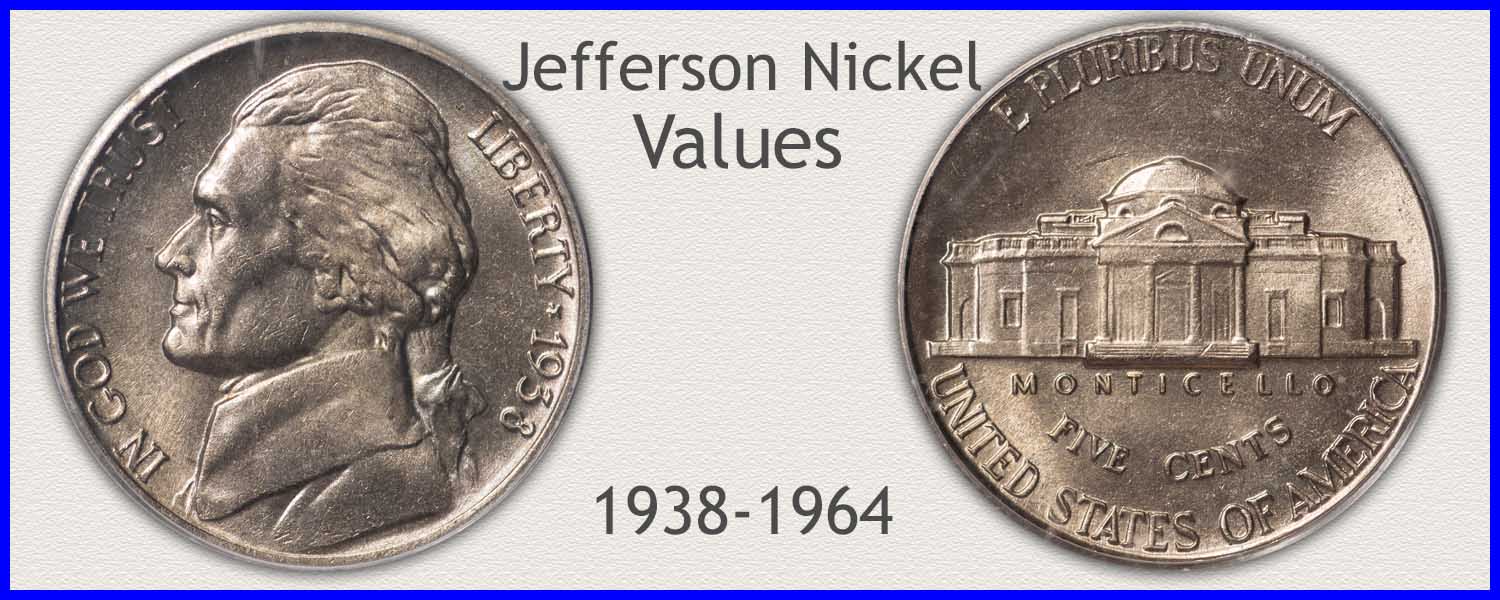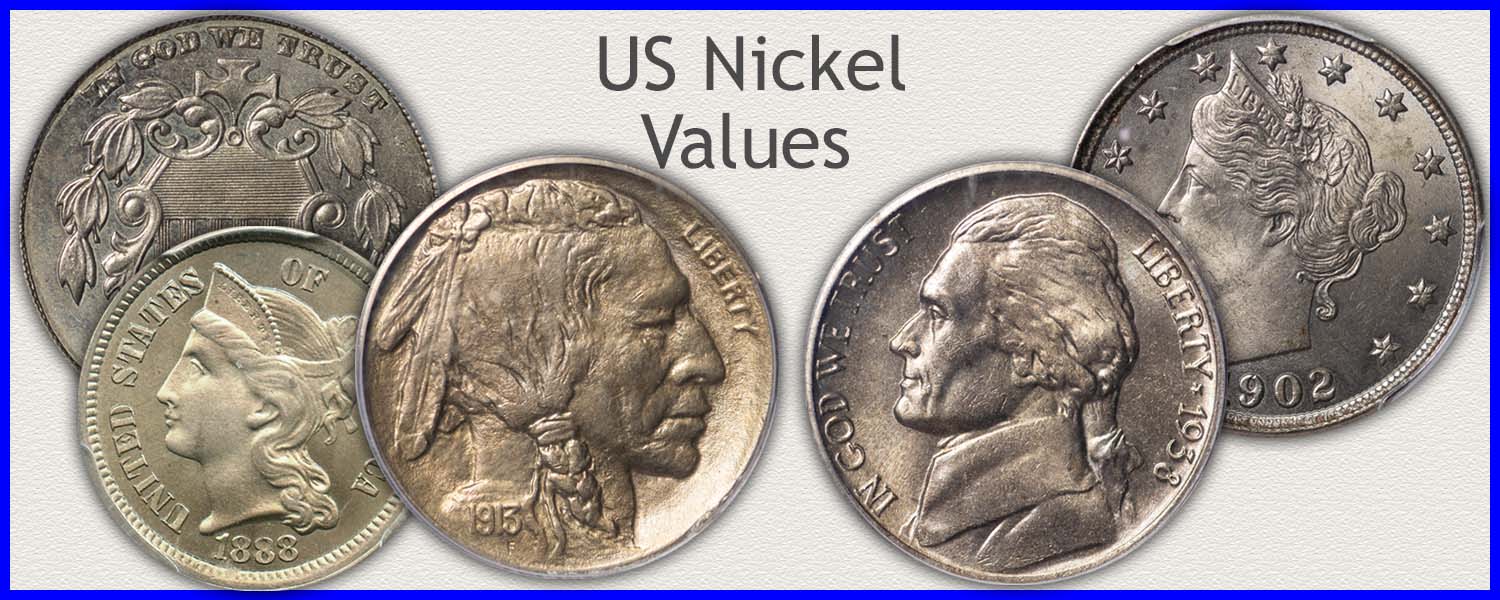Coin Values Moving with Precious Metals: Up-Dated 4/14/2025: Gold $3226 | Silver $31.88
1952 Nickel Value
Collectors are seeking nice eye appeal quality nickels for collections. Notable is the lack of quality 1952 issues. Follow a step-by-step process to identify the mint varieties, condition, and a few added qualities that point to an in-demand nickel.
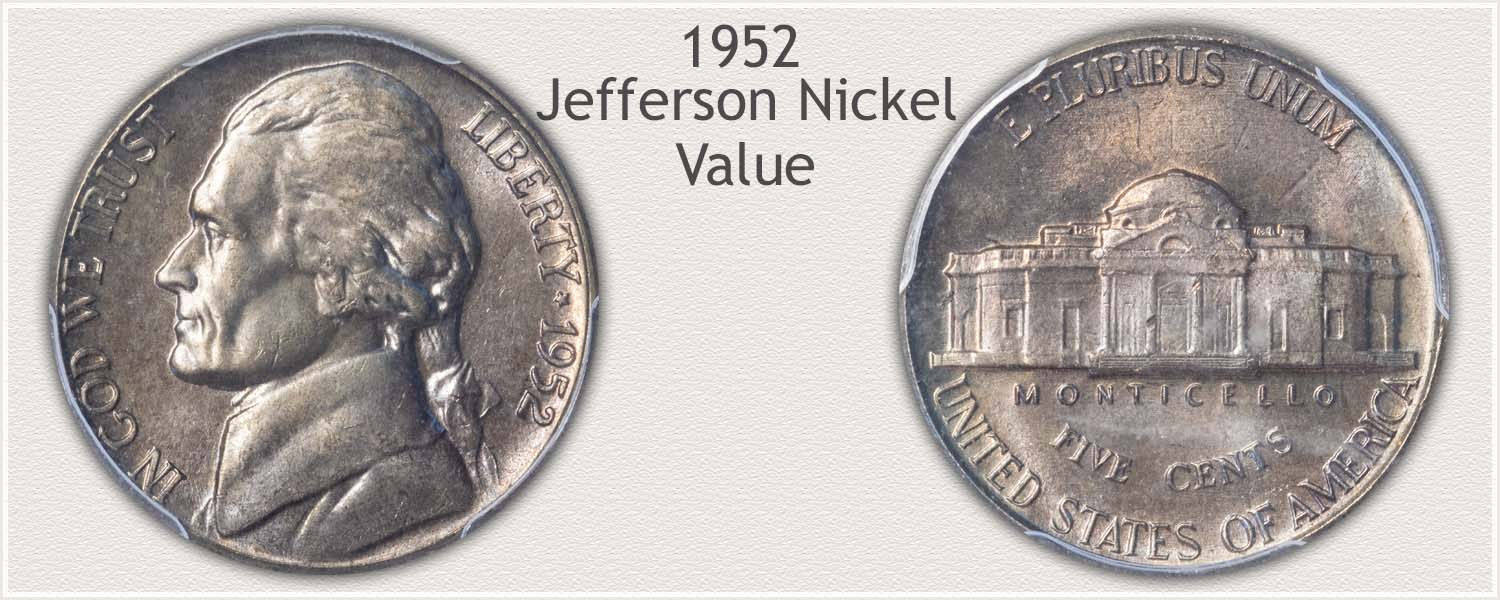
Steps Leading to Value:
- Step 1: Date and Mintmark Variety - Identify the three varieties of 1952 nickels. Value charts list each individually along with grades to narrow how much they are worth.
- Step 2: Grading Condition - Comparing to images representing different grades helps judge condition.
- Step 3: Special Qualities - Many variables either raise or lower the appeal of old nickels. Recognize a quality coin without any damage or corrosion.
| 1952 Jefferson Nickel Value | ||||
|---|---|---|---|---|
| Condition of Coin | ||||
| Date | Good | Fine | Extremely Fine | Mint State |
| 1952 Jefferson Nickel Value Up-Dated | 2025 | |||
| 1952 | $0.05 | $0.05 | $0.05 | $1.83 |
| 1952 D | $0.05 | $0.05 | $0.05 | $3.08 |
| 1952 S | $0.05 | $0.05 | $0.05 | $1.53 |
Judging quality is the important part to how much a 1952 nickel is worth. Ample quantities were produced and remain today. It is the condition of the coin that has the most potential to adding collector appeal and premiums. A step-by-step method is followed comparing with images to both identify the date and mint variety and condition. A collectible quality nickel is recognizable.
Step 1: | Date and Mintmark Variety Identified
Three Varieties of 1952 Jefferson Nickel to Recognize
Abundant numbers produced and availability defines the 1952 nickel and its mint varieties. Plenty were struck at three mints: Philadelphia, Denver, and San Francisco. One point to keep in mind is all three varieties are collected as part of a complete Jefferson nickel set. A steady demand results.
Important to identify is the different mint's coinage.
1952-S Jefferson Nickel
"S" Mintmark on Reverse: San Francisco Mint Struck the Coin
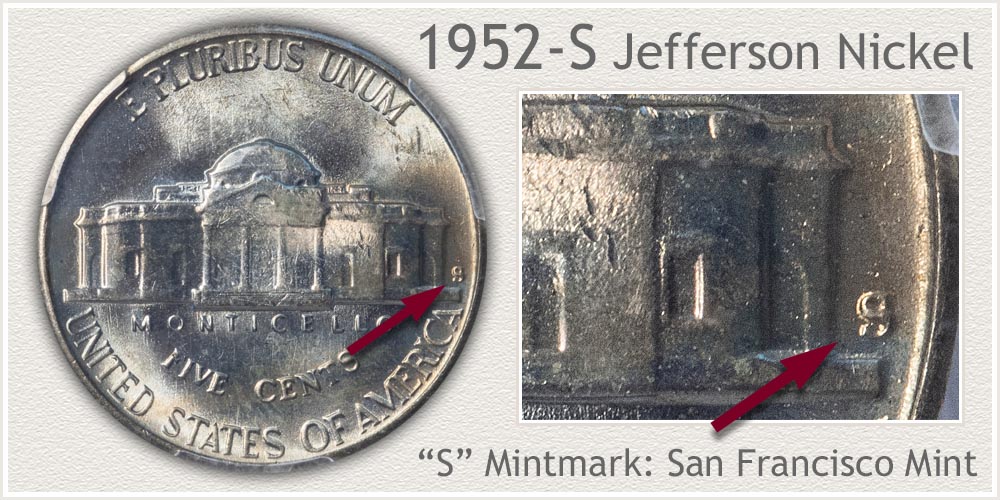
San Francisco mint, supplying the west coast, struck the fewest 1952 nickels of the three mints. 20,572,000 released into circulation, with almost all becoming worn from usage. Enough were saved in both mint state and circulated - worn condition that ample supplies remain. The challenge faced by today's collector is finding pleasing examples.
Mintmarks identify the different mints. An "S" on the reverse is used by San Francisco. Look to the right side of Monticello, a small "S" next to the rim is the identifying mintmark.
1952-D Jefferson Nickel
"D" Mintmark on Reverse: Denver Mint Struck the Coin
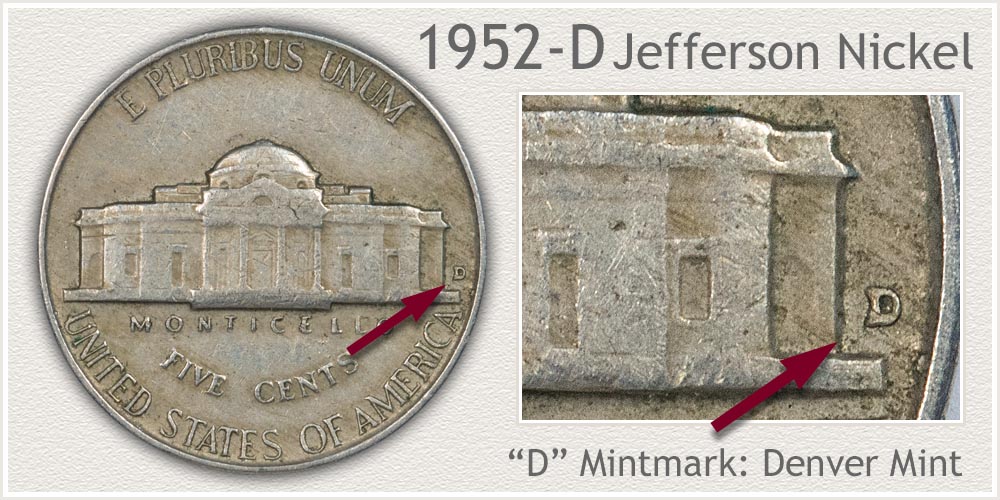
Centrally located in the U.S. the Denver mint produced over 30 million nickels dated 1952. These are available today and are sough in a high state of preservation. Many nickels of the early 1950's have circulated extensively and become worn, damaged, or lost.
To identify the Denver mint production a "D" mintmark was placed on the reverse. On the right of the Monticello, a "D" is beside the building next to the rim on Denver mint nickels.
1952 Jefferson Nickel
No Mintmark on Reverse: Philadelphia Mint Struck the Coin
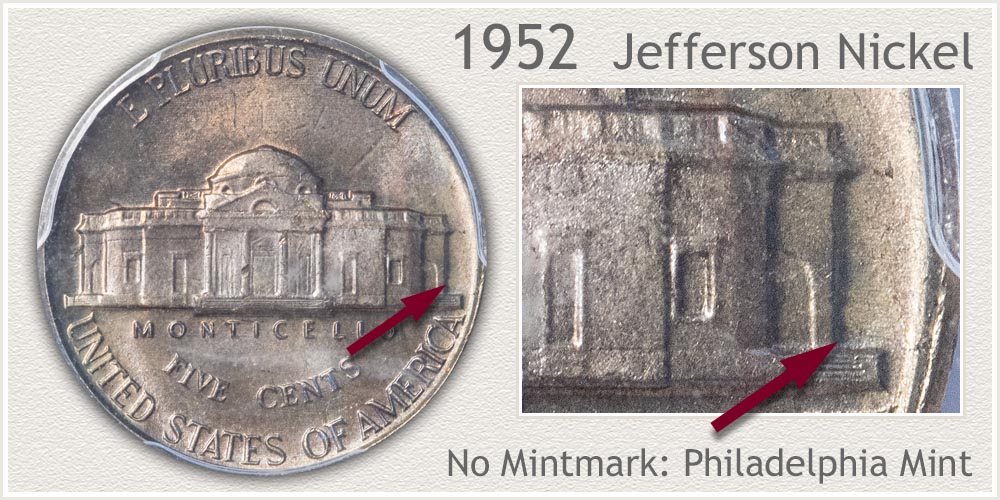
Philadelphia 1952 nickels are the third mint variety of the year. With over 64 million coined these are seen often in circulated condition. Mint state grade examples - no wear to the surface - are the preferred condition sought by collectors. However, lightly worn examples are affordable to new and beginning collectors, creating a demand for these.
No mintmark was used in 1952 by the Philadelphia mint. The absence of a mintmark confirms the variety. On the reverse to the right of Monticello, if the area is empty, Philadelphia struck the coin.
Step 2: | Judge Condition to Identify Grade
1952 Jefferson Nickel Value is Conditional
Grading a coin takes a comparison approach. Your coin is closely examined and matched with the image of a coin representing the grade. Stages of wear are recognizable by the reduction in design elements in a progression. Mint State coins without wear show complete contours and fine details. As wear removes metal, design elements begin to fade and merge.
Starting with the Mint State grade highlights the complete design to reference helping gage the amount of metal missing as wear begins.
Mint State Grade
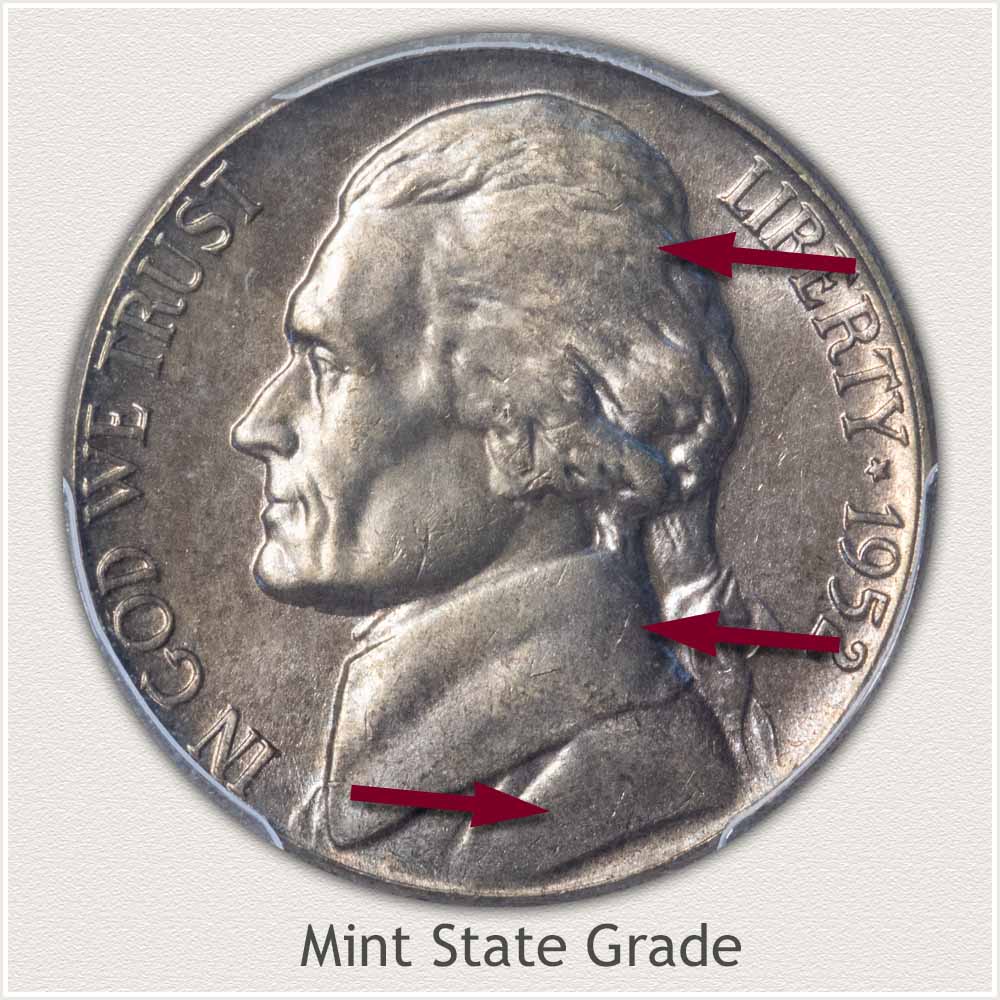
Mint State: Top condition coins are as they left the mint, without any wear to the surface. The striking process imparts a fine texture of luster to the metal giving the "shine" of a new coin. Presence or absence of luster is used as an indicator of slight amounts of wear.
Jefferson's portrait is high in relief, raised well above the field of the coin. His coat collar and shoulder area are very high in profile and typically wear appears here first. Luster covering the collar line where it meets the shoulder confirms a mint state grade. Notice on the example, no dulling or lack of shine to the shoulder, color is even across the area from the neckline to lower rim.
Checking the entire coin finds no breaks in shine throughout Jefferson's hair, specifically the high points. A nice mint state grade 1952 nickel.
Extremely Fine Grade
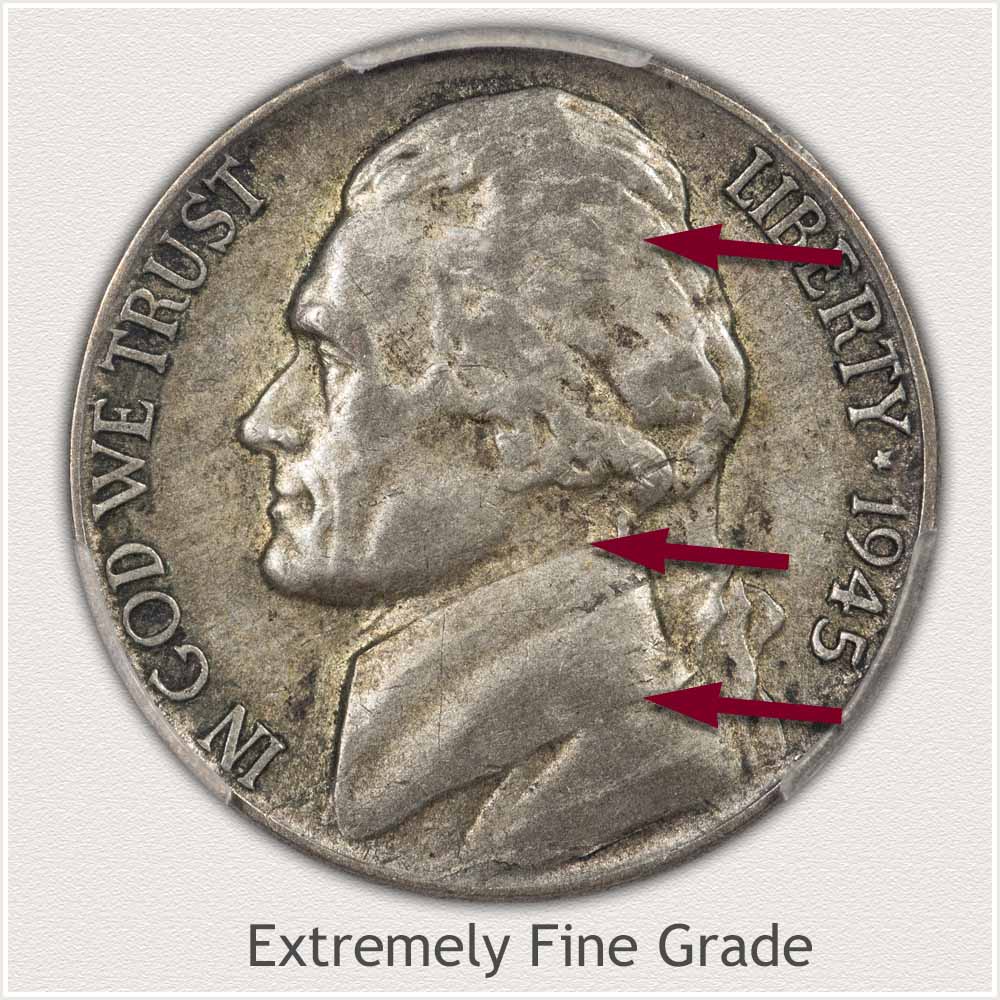
Extremely Fine: High points of the design lightly smoothed by wear defines the Extremely Fine grade. Wear is seen over the entire surface, small amounts of metal is missing, and most of the original luster is gone.
A gage to the amount of wear on the coin is the slight merging of the collar line to the shoulder. The small area of flatness at the lower collar is just beginning to fade into the small wear spot of the shoulder. Notice the collar close to the neck remains well contoured, no distinct flatness. Wear confined to the very highest shoulder area is indicating an Extremely Fine grade nickel.
Jefferson's hair is only worn at the tops of hair lines. Most detail within the hair is well defined. A nicely detailed appearance is important to eye appeal and the grade.
Low Circulated Condition Examples
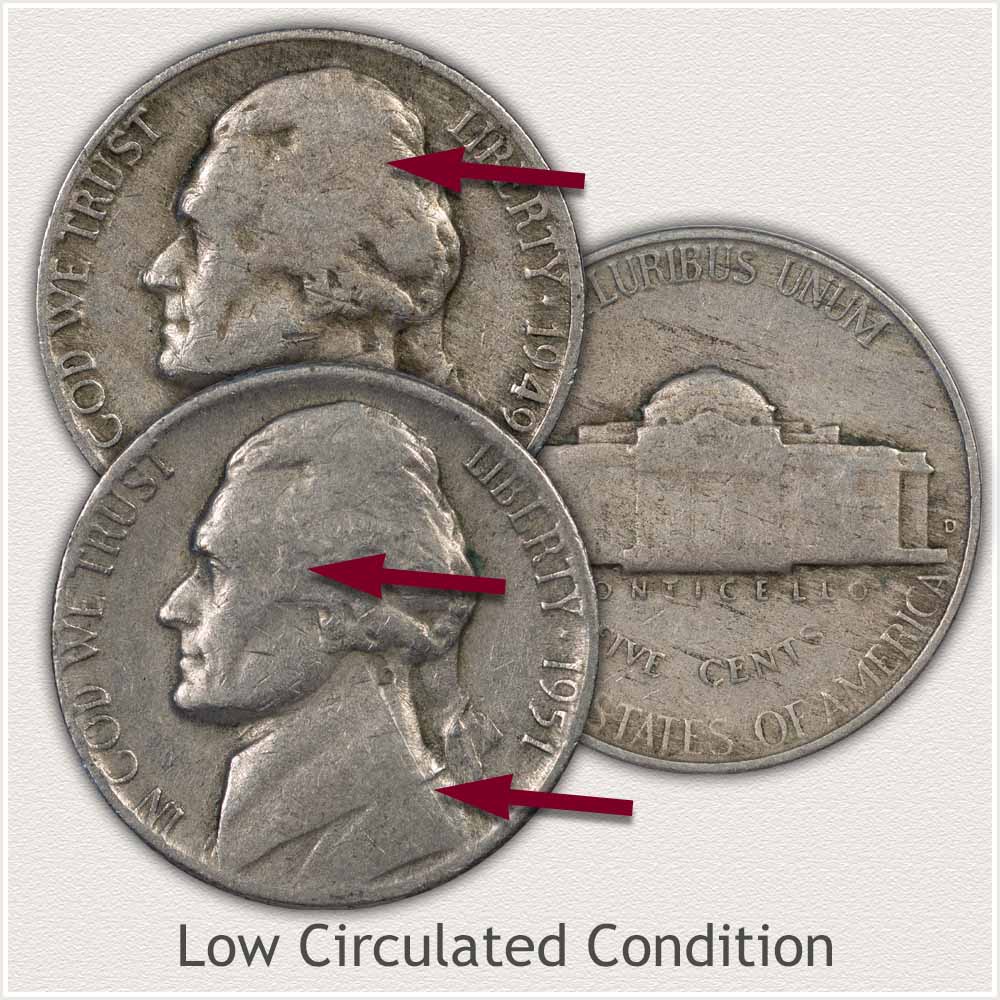
Low Circulated Condition: Lower grade coins are represented by the examples in the image. These coins are now worn below the Extremely Fine grade. Worn over the entire surface, low condition coins lack the original fine details.
An inspection of the collar and shoulder of Jefferson shows the collar line is missing and completely smooth across the high point. One large flat area is now connecting the shoulder extending upward into the collar.
Jefferson's hair is now completely smooth with just a few hair lines visible towards the back. His face shows large flattened areas of the once high contour cheek and jaw. Noticeable flat areas now extend down from the top of his head, through the face, and across the shoulder to the lower rim.
Moderate to heavy wear identifies a lower condition Jefferson nickel.
How to Video: Grading Jefferson Nickels
Examine all parts of the coin's surface to confirm a grade. Additional descriptions pointing to example images help recognize subtle differences in condition and value.
Video, Images and Descriptions | Grading Jefferson Nickels
Step 3: | Special Qualities Enhancing Value
Comparing Eye Appeal of Nickels
Eye appeal is a significant factor to the value of these Jefferson nickels. Mint state coins are examined for nicks and abrasions and beauty of luster and toning. Lack of marks and abrasions on focal points, such as Jefferson's face add to appeal. Pleasing toning enhancing the vibrancy of the design is also another quality appreciated by collectors.
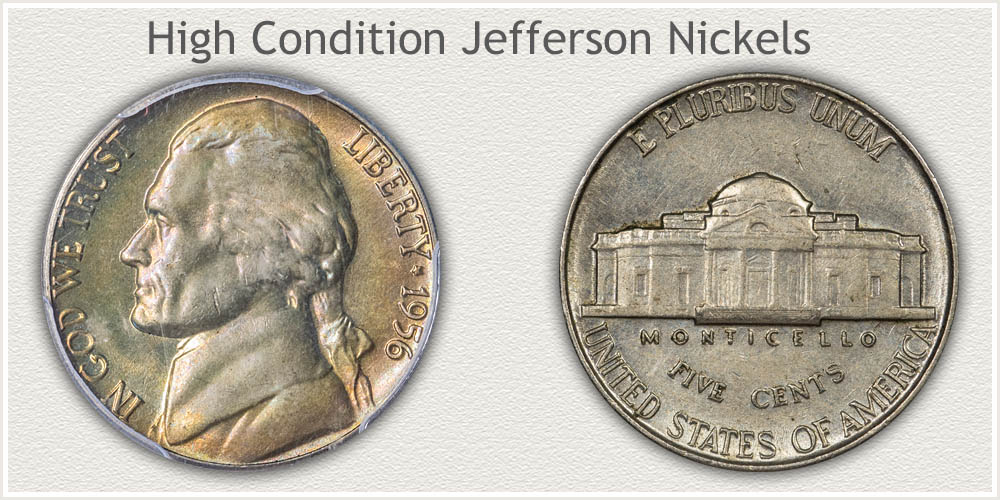
Eye appeal of lightly worn nickels follow the same judgement of qualities as mint state coins. Absence of noticeable marks and abrasions is a plus in the eyes of collectors. Although the coin is worn and luster is missing, a nice, even, natural toning indicates a well-preserved coin since its removal from circulation.
Coins displaying damage and excessive wear and marks fall below the quality sought by all collectors. An abundant number of vintage nickels remain, many affordable to new and beginning collectors. Any coin with "problems" is passed and awarded no premium value.
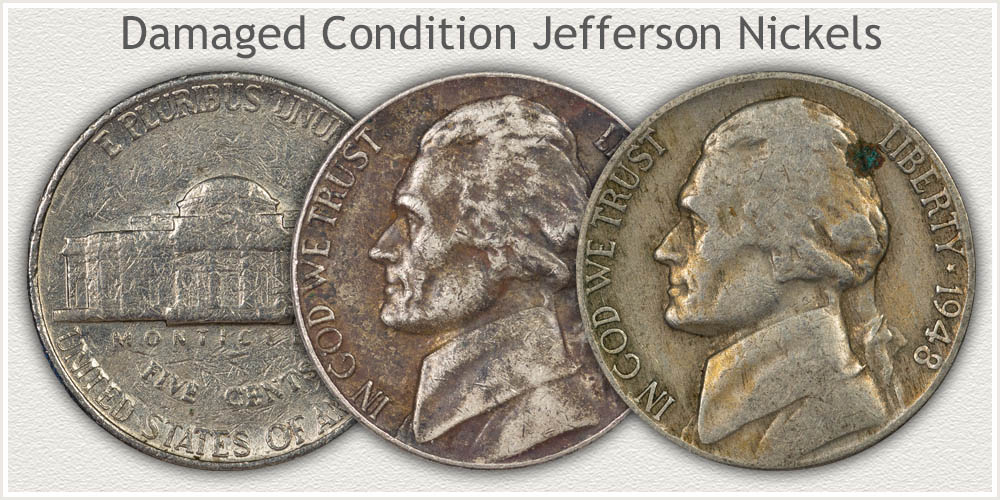
The above are all damaged and show qualities removing them from collector appeal. In the center is the results of corrosion, likely the cause of dampness. Excessive marks are very distracting on the left example lowering eye appeal. A small area of verdigris - the green color- is also corrosion and eliminates the coin as a collectible.
A collectible 1952 nickel has avoided the damage caused by large marks, corrosion and heavy wear. Judge your coins by technical grade and also consider overall eye appeal. Premiums are awarded to quality nickels.
References
U.S. Mint. 1953 U.S. Mint Annual Report https://nnp.wustl.edu/library/book/512052
Coin Values | CoinStudy Articles
Date by Date
In Depth Jefferson Nickel Values
1938 to 1964
Jefferson Nickel Values | Gaining Popularity
Value chart spans the Jefferson nickel years 1938 through 1964. From Mint State grade coins collected by advances collectors, to worn examples, an affordable collection popular with young collectors. Identify date, mint and condition; a wide range of value is found and identified using a step-by-step method.
Old Nickel Values | Guide to Nickels
Starting with the old Shield nickel first minted in 1866 to the Liberty nickel. Followed by the very popular Buffalo nickel. 1952 nickels are part of the long running denomination. Value Charts and grading images identify rare nickels.
Print the Coin Values Worksheet
List your Jefferson nickels and record their values. Identify and organize your collection, and keep a summary of all coins.
Coin values are influenced by the popularity of a series. Large numbers of collectors create demand showing in premiums paid for coins. Collecting interests are ranked on charts by denomination and series. Understand how popular and solid values of a coin collection are.
Coin Value Guide | How to Value a Coin Collection
Placing a value on a coin collection is done by following a step-by-step method. Each series is identified with images, important dates are highlighted. Grading condition, one of the important steps is accomplished with images of grades to compare your coins. An organization of your coins is part of the process.
★ Coin Values Discovery finds 1952 Jefferson Nickel Value and...
All old US coin values. Value charts in combination with grading images to judge condition discovers how much your old coins are worth. A step by step process finds the value of your coin collection.
